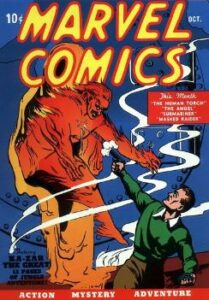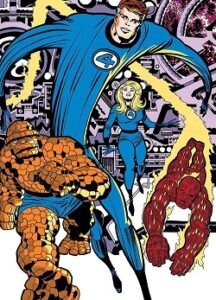Entertainment is one of the most prominent character-based entertainment companies in the world. It is built on a library of over 8,000 characters featured in a variety of media over seventy years, out of which one of the most popular media is Marvel Comics. Marvel has utilized its character franchise in entertainment, licensing, and publishing as well.
Marvel Comics are a classic; they are of a very refined genre and have the most extraordinary stories in the business. Almost every living being has read them once in their life, and for some, it is a lifelong love. These comics have bewitched generations over generations among multiple media platforms for the past decade.
In this day and age, Marvel Comics has gone from being a small magazine to revolutionizing the entertainment industry. These comics have greatly affected the world, and we are here to contribute to your knowledge about them.
Here is everything you need to know about the early history of Marvel Comics.
Timely Comics & Publications
A man named Martin Goodman founded the company named Timely Publications in 1939, which published comic books under the name Timely Comics. Martin started this journey with Pulp Magazines in 1933; he then expanded and emerged into the highly popular medium of comic books. Taking advantage of the comic book craze, he created a new storyline to satisfy the comic delights of the people.
Timely Publications was located at 330 West 42nd Street, New York City, and Goodman, alongside Abraham Goodman, got to work on the comic book mania. Timely’s first publication was Marvel Comics # 1 in October of 1939. It revolved around the tale of a human android called The Human Torch, and the villain of the story was a submariner known as Namor. This publication was a massive hit and sold nearly 900,000 copies within the first two months of the launch.
By the next year, Timely Publications had a whole working team, which included Joe Simon and Jack Kirby. These two people in 1941, introduced the insanely popular, politically themed, star-studded superhero known to the world as Captain America.
After the years continued, more competent and lovable heroes came into being, which included the original Vision, Whizzer, Miss American, the Angel, and the Destroyer.
Later, Goodman hired his wife’s cousin, a man named Stanley Lieber, who showed exceptional skills, and soon, he worked his way up to become an editor of the company. He created many diverse characters and was known as Stan Lee, a title he held for the rest of his life.
It was true that Timely Publications had outstanding business skills and was on its way to becoming incorporation, occupying the comic empire.
Marvel Comics
During World War II, the comic book era started to fade. Most publication companies started producing western comics, adventure dramas, romance comics, and any other publications that would help them earn some money. Timely Comics, too, published these through Atlas Comics. They were cheap and fast rather than high quality, which is why it was a success.
Goodman’s business strategy involved various magazines and comic books publishing his work by several corporations, all operating out of the same office. One of the shell companies through which Timely Comics was introduced was named Marvel Comics. Goodman formally adopted the name Marvel Comics in 1961.
Soon after, DC revived their genre, and Marvel rose to the occasion. DC heroes were created to cater to a younger audience; whereas, Marvel decided to appeal to mature spectators. This led to the creation of The Fantastic Four by Stan Lee. This creation went off the charts and broke comic conventions. It paved Marvel’s way towards the discovery of more amazing heroes such as The Amazing Spider-Man.
Marvel introduced photo-realism in comic books and was found to be more relatable than DC heroes. Further, in the game, Marvel boomed into popularity with amazing and inspiring superheroes such as the X-Men, The Incredible Hulk, Thor, Iron Man, Daredevil, and many more. They all came together in the Marvel Universe and left people in awe.
Comics Code & Branching Out
In 1954, the Comics Code Authority was formed. Its job was to censor and regulate the content being published in comics. The Comics Code prohibited large amounts of graphic violence, suggestive themes, and drug content. It also inhibited the use of werewolves, vampires, or situations and plots where villains prevailed in the end. Many writers found this as a hindrance in their work, as it limited their imaginative capacity and ideas.
Decades later, the Comics Code was updated and renewed; it allowed more content to pass through censorship. This led to Marvel branching out and creating new, outstanding comics of all sorts such as Howard the Duck, Conan the Barbarian, The Tomb of Dracula, etc.
During this time, Goodman decided to step down, and his son, Charles (known as “Chip”), took his job, later he was found to be very incompetent, so the position was given to Stan Lee. Marvel skyrocketed from that point onwards. They even managed to pull ahead of DC comics, making them the top comic book distributor in the world.
Marvel also decided to do a lot of license work for movies and TV shows in this era, such as Star Wars. In 1978, Jim Shooter became the editor-in-chief and fixed a lot of the publications and business errors that Marvel had up until this point.
In the early and mid-’80s, Marvel lost some ground to DC because their work was low-rated and defected as compared to their rival. Yet, Marvel still kept a very firm steady ground in the comic market.
The Rise & Fall of the Comic Book Empire
By the late ‘80s, Marvel was slaying in the game. The greatest artists of the time, such as Todd McFarlane and Jim Lee, were working and drawing for Marvel – while making the company huge profits. The comic book industry as a whole was doing amazing.
The first issue of Spider-Man sold more than two million copies; this completely rejuvenated the character and managed to create an era and mark its prominent place. Talking about first issues, the first issue of X-Men sold eight million copies, and to this day, it is the most comics sold for one issue.
It was all fun and games until Marvel took a massive blow in 1992 when seven of their most dominant and legendary artists claimed to quit to create Image Comics.
By the mid-‘90s, the comic book empire was almost completely thinned out due to fan conjecture and poor decision making on the part of companies. This Comic Book Crash struck Marvel so badly that in 1996, the Marvel Entertainment Group filed for bankruptcy. To escape their financial situation, they even sold off movie rights of their big-gun characters such as Spider-Man, X-Men, and The Fantastic Four.
Fortunately, in the late ’90s, Marvel managed to get back some old employees to help them out with just enough to make it into the next decade.
The Golden Age
The beginning of the next decade was quite rough for Marvel, as they had already sold the rights of their characters to studios. The filmmakers had started churning out movies, and by 2002, Men in Black, Blade, X-Men, and the super hit Spider-Man were already premiered.
Marvel had to do something new and unique to get their power, name, and authority back in the market. So, they decided to leave the Comics Code Authority and had the new diverse idea of creating their rating system.
In 2007, Marvel even digitized their comics to make it more accessible to the new readers. Then the Marvel Ultimate Universe was created. It gave new origins to characters and engaged the audience even more than before.
In 2008, Marvel Studios stunned the digital media with their incredibly triumphant Iron Man movie, which saved the comic book industry from expiration. Iron Man was initially the first B-listed character to roll out a series of movies that were interconnected. This set the building blocks for the Marvel Cinematic Universe (MCU).
The Amalgamation of Disney and MCU
The turning point of Marvel Cinematic Universe came when Disney announced that they would conglomerate with Marvel Entertainment on August 31, 2009. This helped Marvel create new characters, distribute their comics to an even bigger audience, and helped create more movies.
Marvel started to ramp up, and Disney saw great success; both parties were at acme. During this time, the world received The Incredible Hulk, Iron Man 2, Thor, and the revolutionizing First Avengers movie. This continued with sequels and the addition of more characters such as Ant-Man, The Guardians of the Galaxy, Black Panther, and many more.
All-New, All-Different Marvel
By 2015, Marvel saw success in the film industry as an opportunity to relaunch new Marvel comics. People initially started bouncing back to comics for more information about the characters from movies that they loved. Many stunning comics came out in this modern era like Civil War, Spider-Man: Spider-Verse, Old Man Logan, etc.
Later in 2017, Marvel Legacy was released, which met many objections by book stores such as them not selling well. Sadly, the comic books were not doing as well as the movie industry. In 2018, Marvel Comics announced a return of Conan comics and a Big Hero 6 comics, and with that, the comic book story remains stagnant.
Final Verdict
In the future, we hope Marvel will continue to produce the familiar titles that we all know and love. We hope to see MCU prosper with quality content, leaving Marvel comics and Disney as one of the greatest entertainment studios in the world.




